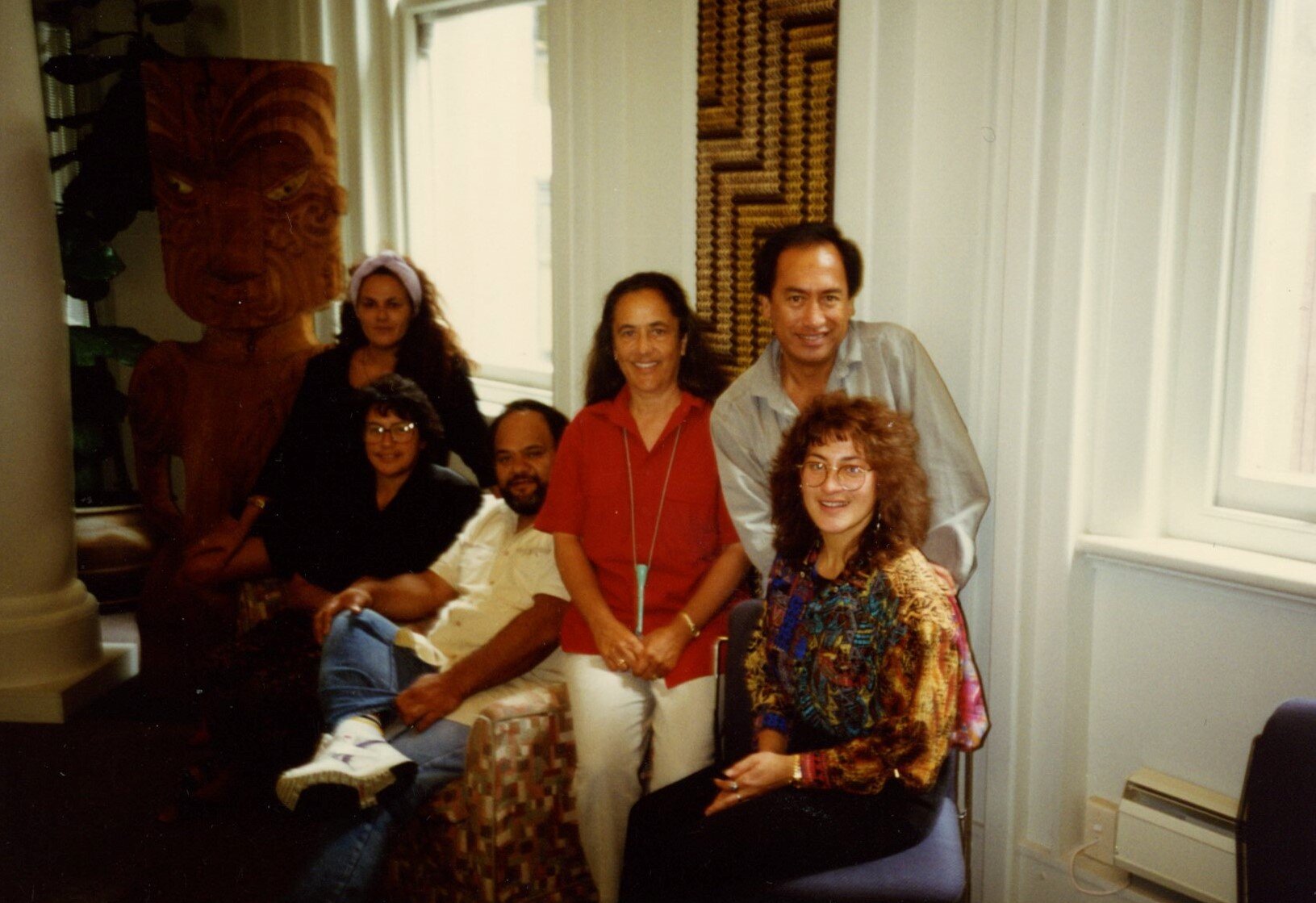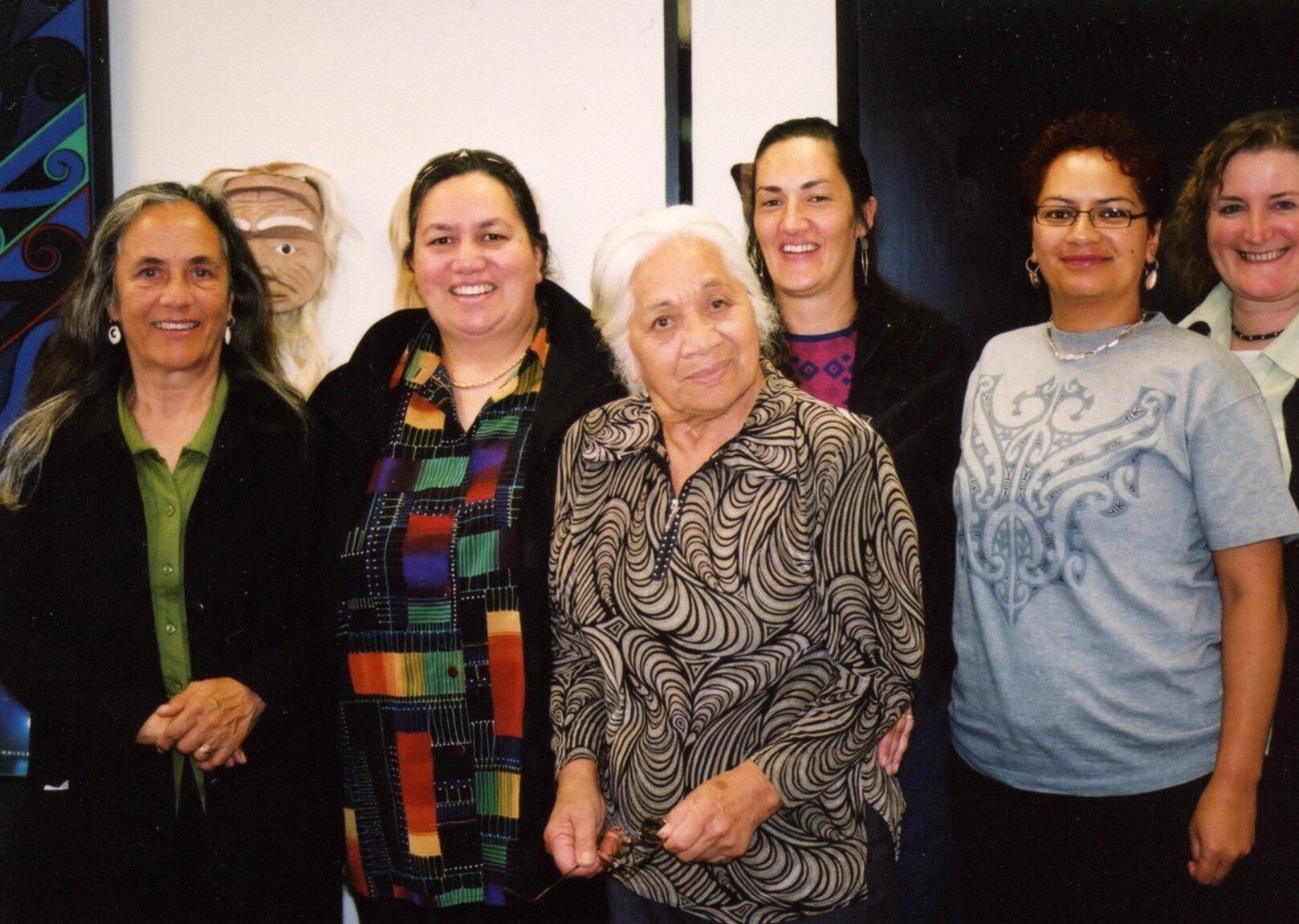




Tuia Te Kōrero with Patricia Grace
~ Remembering the beginnings of Te Hā ~
Te Hā ki Te Ūpoko o Te Ika (Pātaka Education Space, April 6, 2019)
Kia ora! Nau mai haeremai. This collaborative, working document was put together by people who attended a hui at Pātaka Education Space, on April 6, 2019. The purpose of the hui was to reflect on the history of Te Hā through the memories of Patricia Grace. The notes that follow are taken from Patricia Grace and Paul Diamond in conversation. This is just a beginning of a history that we hope will be picked up and filled in by all those with memories to share!
Origins of Te Hā:
The origins of Te Hā go back to the late 80s/early 90s and possibly grew out of Ngā Puna Waihanga, a national body for Māori artists and writers set up in 1973. Tungia Baker came up with the name Te Hā. The aims were to identify, encourage and promote new writing by Māori. ‘Te Hā is the perfect name. It refers to the breath, to the very essence of who we are. You draw in, you give out. Simple, really.’
Te Hā originally kicked off in response to a lack of funding. Early conversations in those days were about the obstacles to accessing funding, but things quickly moved towards the aims of identifying, encouraging and promoting new writing by Maori. Patricia acknowledged some she called ‘real trailblazers,’ including Rowley Habib, JC Sturm, Arapera Blank and Meihana Durie, who was writing short stories then.
What Te Hā did:
Te Hā ran many initiatives, including:
Regular meetings – discussions about Māori literature, publishing, breaking down stereotypes, etc.
Running writing workshops
Running writing competitions, one of which was named after Te Ātairangikaahu.
Holding readings
Promoting Māori writers into book festivals and indigenous arts festivals (Australia, Canada), and organising billets for our writers while there.
A display of 100 books across all genres, even those that had been self-published (e.g. Rose Pere’s Te Wheke)
The creation of a bibliography of ‘everything that had ever been published by a Māori writer in English’. The original project extended to searching old newspapers for even a single poem that may have been published by a Māori writer. This project went on to become a PhD project completed by Bridget Underhill through Canterbury, and that incredible resource including the work of over 1,600 writers can be found here.
The early Te Hā movement included writers writing in te reo, but this group eventually split off. As Patricia said, ‘it was a bit hard to do both’. The new splinter group was possibly called Te Reo Take Kōrero, and was chaired by Hirini Moko Mead.
Te Ao Hou, the Māori Affairs Journal, was not part of Te Hā, but was another significant resource at the time providing a publishing pathway for writers.
A big driver behind Te Hā was the desire to break down stereotypes. In Patricia’s words:
‘At that time you could count the number of Māori writers on one hand, and the trouble with stereotypes is that when there are not enough people who are Māori and who are writing there aren’t enough reflections out there of who we are. (And that starts to have the opposite effect – people think what you’ve written IS the stereotype – Witi Ihimaera even stopped writing for a few years because of that.) We are as diverse as any people are. But that wasn’t how we were seen.’
Patricia Grace
‘You write what you know, but there needs to be enough of you to show the landscape.’
Patricia Grace
‘None of us started out as Māori writers. Other people put the label on you. I was fine with it, it didn’t stop me doing what I wanted to do. Not everyone likes that label.’
Patricia Grace
‘The written word has been something I have always loved, from the minute I jumped out of my mother!’
Patricia Grace
The crucial question of ‘who is a Māori writer’ had always been there. People like Witi and Keri Hulme were always being questioned about their background. Witi’s response to the flack from the public was to stop writing for some time. And then he began to publish anthologies. What he was saying with these anthologies – full of diverse stories (here Patricia held up a copy of Into The World of Light – was that whakapapa alone is sufficient to identify you as a Māori writer.
‘And this was great, because we began to see the spectrum of writers, ranging from Arapera (raised in te reo and te ao Māori) to Bub Bridger, who only discovered she had Māori whakapapa when she was in her thirties. Witi’s anthologies captured the variousness of who we are.’
Patricia Grace
In fact, Patricia went on to suggest that the fact of having an identity that was ‘in question’, complicated or confused, was probably one of the defining factors of Māori writing and being Māori. ‘Other people put labels on you… I didn’t set out to be a Maori writer.’
On readers and reviewers of Māori writing:
Te Hā also discussed the way writing was being reviewed and critiqued by non-Māori. Miriama Evans and Patricia were both interested in this and involved Pōwhiri Rika-Heke.
Likewise, there were discussions about the lack of Māori readers/reviewers:
‘Our books were being reviewed by Pākehā reviewers and you could tell that what we were writing about just didn’t compute. I talked with Miriama Evans and we asked ourselves, “Where are the Māori scholars studying the work?”’ There were no pathways to study Māori literature or Māori writing at university, so they shoulder tapped Pōwhiri Rika-Heke. She could find no uni here to study this subject at, and ended up doing her research in Germany, ‘including possibly a PhD on indigenous, possibly indigenous women, writers’.
Patricia Grace
Patricia mentioned Bub Bridger’s poem I want a Whetton for Christmas. (Twins Gary and Alan Whetton, b. 1959, both played for Auckland and then the All Blacks.) Here’s an excerpt
A Christmas Wish
I want a Whetton for Christmas!
Either Alan or Gary would do . . .
I’d l-o-o-o-o-ve a Whetton for Christmas
For some frolicsome festival woo
But – they tell me that Gary is married
Still . . . Alan is there to be plucked
And his eyes and his thighs are s-o-o-o-o sexy
And his body just made to be . . . admired.
In closing, Patricia talked about her own upbringing, moving between Hongoeka and Melrose, and made the beautiful comment: ‘I’ve always felt perfectly secure in both my cultures’.
Additional names mentioned:
Hone Tuwhare
Haare Williams
Bruce Stewart
Api Taylor
Anton Blank
James George
Additional links:
http://beattiesbookblog.blogspot.com/2009/12/tribute-from-iiml-newsletter-bub.html
http://www.stuff.co.nz/dominion-post/news/obituaries/3156858/Free-spirit-who-tamed-words
https://www.noted.co.nz/archive/listener-nz-2015/patricia-grace-a-writer-a-fighter